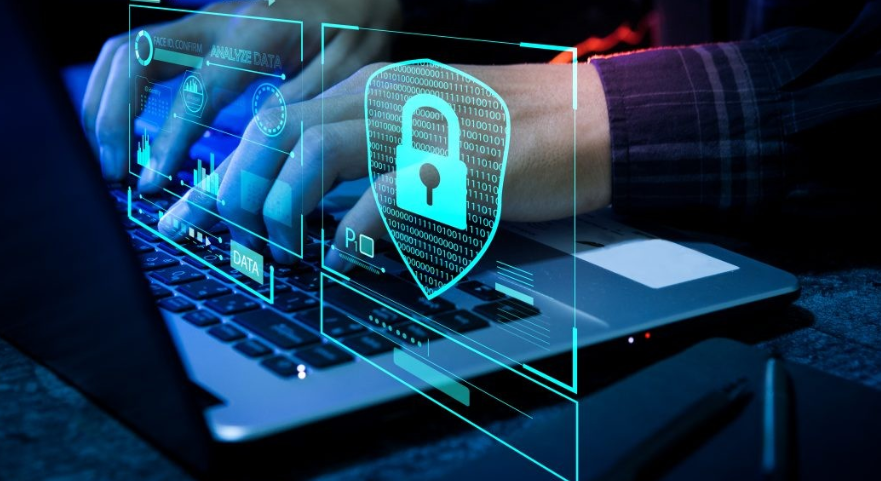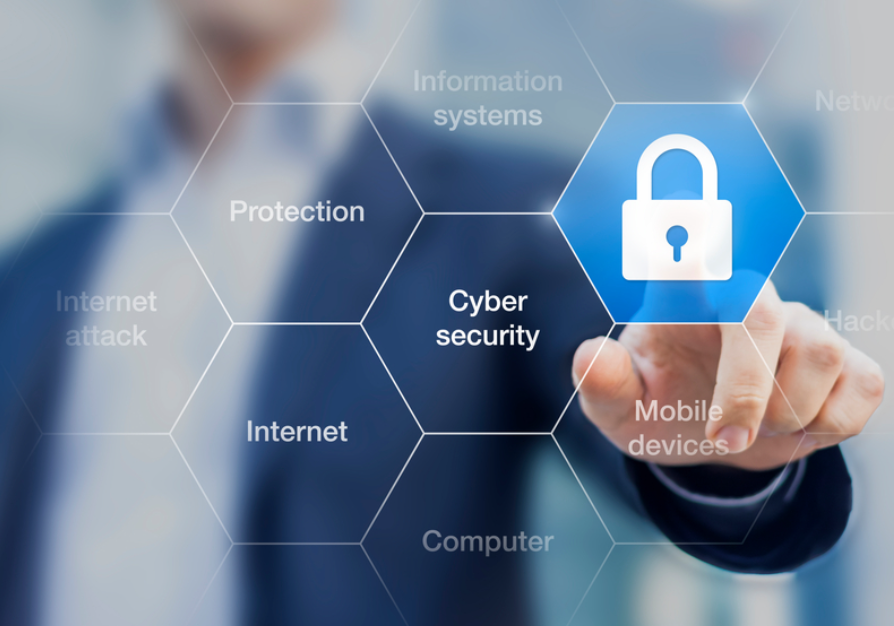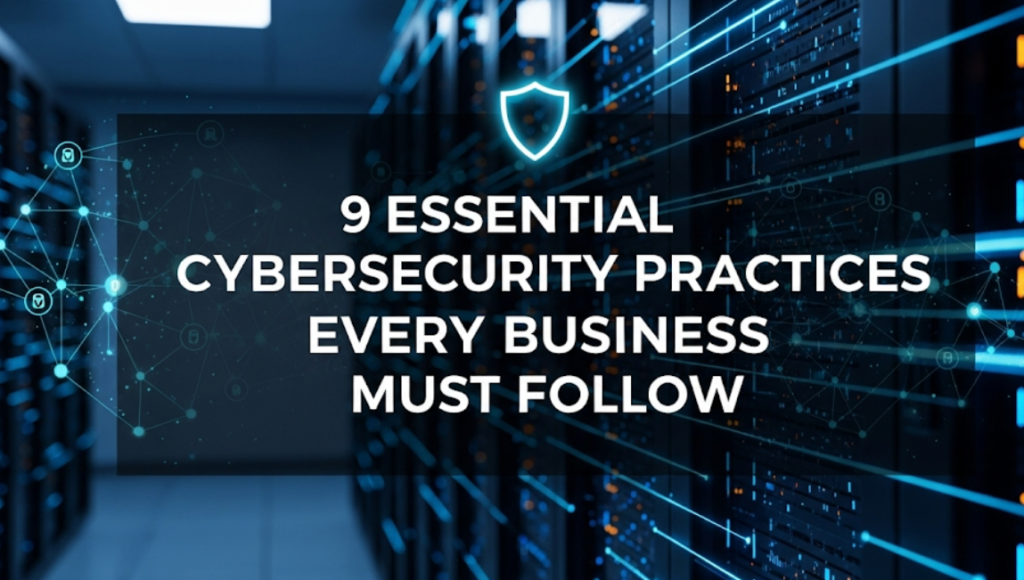Introduction
Modern business operations have been relying on cybersecurity practices. Hackers carry out more than 2,200 cyberattacks every day. This translates into one attack every 39 seconds.
Small business is at the greatest risk. Small companies are the targets of almost 43% of all the cyberattacks. However, it is only 14 percent of those businesses that are ready to defend themselves.
The price of data breach continues to increase. The average cost in 2024 was $4.88 million per incident. This figure indicates why intelligent cybersecurity measures are more important than ever.
Your business information is precious. Protection is required on customer details, financial data, and trade secrets. Lack of proper security would mean losing all you have worked hard to accumulate.
This manual has nine security tips. These will assist in securing your business against cyber attacks. All of the steps are simple to comprehend and apply. These rules need not be followed by a tech professional.
The Importance of Cybersecurity to Your Business
The cyber threats are increasingly becoming stronger every year. Hackers have sophisticated tools to access business systems. They rob cash, information, and confidentiality.
One attack is enough to ruin your name. Clients no longer trust companies unable to secure their data. This disruption is usually long term.
There are also legal issues that come in the wake of data breaches. Protecting customer data is mandated by new privacy laws to businesses. Violation of these rules results in huge fines.
The good news? Most attacks are prevented by good cybersecurity practices. By using simple security measures, you will keep hackers out of your business.
1. Establish Strong Password Policies
Hackers have the easiest time breaking in through weak passwords. Simple passwords such as “123456” or “password” are still in use by many people. Such decisions jeopardize your whole business.
Working Password Requirements
The rules to include in your password policy are:
- Minimum 12 characters long
- Mixed case letters
- Include numbers and special symbols
- No personal information or dictionary words
- Different passwords for each account
Make Passwords Easy to Remember
Very long passwords do not appear to be easy to remember. Instead, use passphrases. Take four random words such as “Coffee-Mountain-Blue-Guitar.” Such a technique generates powerful passwords that can be recalled by individuals.
Password managers relieve the memory issue. These applications generate and save highly sophisticated passwords for each account. All an employee has to do is create just one master password.
Regular Password Updates
Reset sensitive account passwords every 90 days. This will reduce harm in case of theft of a password. Install automatic reminders so that no one forgets.
Educate your staff about password security. Not all people understand how unsafe weak passwords are. Ongoing training makes security a priority.
2. Install Multi-Factor Authentication
Multi-factor authentication (MFA) is an additional security check. Hackers can steal a password, but this is not enough as they cannot access it without the second factor.
How Multi-Factor Authentication Works
MFA involves two or more methods of proving:
- Something you know (password)
- Something you have (phone or token)
- Something you are (fingerprint or face scan)
Accounts are even more difficult to crack using this system. To get in, hackers have to access multiple objects.
Best MFA Methods for Business
Text message codes are common but not strong. Phone numbers may get stolen or sold to hackers.
Authentication applications are more effective. Authy and Google Authenticator create codes on your device. These codes are updated every 30 seconds.
The ultimate security is with hardware tokens. These miniature devices produce different codes. They cannot easily be hacked remotely as in the case of phones or computers.
Rolling Out MFA Company-Wide
Begin with the most important accounts. Email, banking, and cloud storage require MFA right now. Then expand to other business applications.
Keep the process easy for employees. Give precise instructions for setup and provide help where necessary. Complex systems are resisted and prone to error.
3. Maintain Software Patches and Updates
Outdated software has security loopholes. These are the weak points which hackers are aware of and take advantage of every day. These vulnerabilities are patched in time before attacks occur.
Operating System Updates
Windows, Mac, and Linux periodically issue security patches. When you can, use automatic updates. This guarantees the speed at which your systems are repaired.
Important updates must install automatically. Waiting to conveniently update is not an option. Periodically plan maintenance times when key updates will be made.
Application Security Patches
Software used in business requires upgrades as well. Security fixes are made to email programs, web browsers, and office applications. Check for updates at least once a week.
Create an update schedule for all business applications. Assign somebody to manage patches and monitoring. This individual must know what updates are critical.
Managing Update Schedules
| System Type | Update Frequency | Priority |
|---|---|---|
| Operating System | Weekly | High |
| Security Software | Daily | Critical |
| Web Browsers | Automatic | High |
| Business Applications | Monthly | Medium |
| Extensions/Plugins | Bi-weekly | Medium |
Test updates in a non-hazardous environment. Business applications can be broken by some patches. A test system will eliminate issues within your main network.
4. Provide Security Awareness Training
Your workers are your greatest asset and your greatest liability. Skilled personnel are capable of detecting and preventing attacks. Hackers get into the company through untrained employees.
Common Social Engineering Tricks
There are hackers who employ psychology in order to deceive individuals. They masquerade as trusted persons or create emergency situations. These strategies are effective as they appeal to human emotions.
The most frequently used trick is phishing emails. The phishing messages appear like they are posted by banks, colleagues, or popular websites. They request passwords or personal details.
There are also scams over the phone. Callers pose as IT support or vendors. They request access codes or information about systems.
Developing Security Awareness
Training consistently reminds people about security. Monthly meetings are better than having an annual presentation. Brief but frequent lessons are more effective.
Give actual examples from your industry. Demonstrate real phishing emails that are directed at your business. This makes the training more relevant and vivid.
Testing Employee Knowledge
Send simulated phishing emails. This shows the individuals requiring additional training without punishment. Turn it into a learning experience and not a blame game.
Encourage good security behavior. Reward employees for reporting suspicious emails or activities. A security-minded culture is developed through the use of positive reinforcement.
5. Implement Regular Data Backups
Backups of data are your security insurance against cyberattacks. Good backups will allow you to restore everything without paying off criminals when ransomware hits.
The 3-2-1 Backup Rule
This rule prevents various types of failures:
- Store 3 copies of valuable information
- Duplicate data on 2 types of media
- Retain 1 copy at an offsite location
By obeying this rule, you will never lose your data even in times of great disasters.
Backup Storage Options
Local backup is fast but prone to physical damages. Your computers can get broken, burned, or stolen along with external hard drives.
Cloud storage provides offsite protection. Cloud services such as Google Drive, Dropbox, or AWS store copies in secure data centers. Your information is protected unless there are internet outages that may slow access.
Most businesses can be best served by hybrid approaches. Store recent backups locally for quick access. Use the cloud to save older copies in case of disaster.
Testing Your Backup System
Backups are not very useful unless you can restore them. Test your backup system once a month. Attempt to restore various files and programs.
Document your restore process. Provide step-by-step instructions that can be followed by anyone. When there is a real emergency, clear directions will help save time.
Time your recovery process. See how much time is required to restore fully. This allows you to plan business continuity during a blackout.

6. Secure Your Network Infrastructure
Your network is the highway that connects all of your business systems. Controlling access to this highway prevents hackers from moving among various sections of your business.
Firewall Protection
Firewalls become security guards for your network. They scan all the traffic in and out and block suspicious activities.
Advanced firewalls do more than just filter. They are able to recognize specific applications and user behavior. Such careful control is used to prevent theft of data.
Make firewall rules simple and effective. Block unnecessary services and ports. Allow only the traffic that your business requires.
WiFi Security Best Practices
WiFi networks in business must be well protected. Encrypt using the latest security standard (WPA3). Avoid WEP or WPA systems, which are quite easy to breach by hackers.
Use different networks for different users. Employees and guests should not share the same WiFi network. This isolation denies visitors access to business systems.
Hide your network name (SSID). This is not airtight, but it makes your network less recognizable to amateur attackers.
Network Monitoring Tools
Install monitoring tools that track your network traffic. These systems are able to identify suspicious activity that could mean there is an attack. If small problems are detected early, they do not turn into big disasters.
Set up alerts for suspicious activity. Warnings should be raised by large file downloads, unusual logins, as well as connections to known bad sites.
7. Limit Access to Confidential Data
All employees do not need to access all information. Restricting access helps to minimize harm in case there is a breach of an account.
Role-Based Access Control
Provide the bare minimum access needed to do their work. Accountants require financial information but not customer service records. Sales personnel require customer contacts but do not require staff payroll data.
Perform access reviews to keep permissions up to date. When individuals switch positions or leave the company, modify their access as soon as possible.
Protecting Customer Data
Customer data should be most secured. Credit card information, social security numbers, and personal information should be encrypted and closely monitored.
Restrict access to complete customer records. The majority of employees require only partial information to perform their job. Customer service may require names and contact details but not financial details.
Data Classification System
| Data Type | Protection Required | Access Level |
|---|---|---|
| Public Information | Basic | All |
| Internal Documents | Standard Encryption | Employees Only |
| Customer Data | Strong Encryption + Audit Log | Need-to-Know |
| Financial Records | Maximum Security | Financial Team Only |
| Trade Secrets | Highest Protection | Executive Level |
Categorize your data in terms of sensitivity. This assists employees in handling various kinds of information appropriately.
8. Deploy Reliable Anti-Malware and Antivirus Solutions
Modern cybersecurity involves numerous layers of protection. Antivirus programs offer necessary protection against harmful programs.
Enterprise-Grade Protection
Antivirus software used by consumers is not effective enough for protecting businesses. Enterprise solutions provide centralized control and improved threat detection.
Business antivirus can monitor several computers from a single dashboard. IT administrators can observe and react to threats across the entire network.
Real-Time Scanning Features
The optimal antivirus software can scan files as they are opened. This real-time security intercepts threats before they can do any harm.
Email scanning is particularly essential. Most malware comes in the form of email attachments or links. Antivirus software will scan emails prior to reaching employees.
Keep Definitions Updated
Antivirus software can only be as good as its threat database. Security definitions have to be updated frequently because new viruses are emerging every day.
Set antivirus programs to update automatically. Manual updates are easily forgotten on busy workdays. Automatic updates keep protection current.
9. Create an Incident Response Plan
Security incidents can still occur despite your best efforts to prevent them. Having a well-defined response plan will reduce damage and accelerate recovery.
Building Your Response Team
Give different people specific roles. Everybody needs to know what to do in case of a security emergency. Confusion wastes time and worsens problems.
Key roles include:
- Incident Commander (makes decisions)
- Technical Lead (handles systems)
- Communications Manager (communicates with customers/media)
- Legal Advisor (handles legal matters)
Step-by-Step Response Processes
Write out all your response steps. Begin with containment to stop the attack immediately. Then focus on investigation and recovery.
Test your response plan regularly. Conduct tabletop exercises that simulate various attack scenarios. This training allows everyone to react well under pressure.
Post-Incident Analysis
Analyze what happened after solving an incident. Find methods to prevent such attacks from occurring again. Revise your cybersecurity practices based on lessons learned.
Document everything in writing. Proper records assist in insurance claims and legal requirements. They also help to enhance your response plan for next time.
Building a Security-First Culture
Technology alone will not save your business. You must have a culture where everyone considers security as part of their job.
Leadership Support
Security culture begins at the top. Employees follow their leaders’ example when it comes to cybersecurity. Make security a routine topic in management meetings.
Invest in adequate security tools and training. Trying to cut corners on cybersecurity typically costs more than being cheap upfront. Security is not an expense to a business; it is an investment.
Making Security Convenient
Complex security processes are usually ignored. Keep your cybersecurity practices as simple as possible.
Supply the tools that employees need to work safely. Password managers, VPN access, and secure file sharing help pursue good security habits.
Measuring Your Security Success
Track your improvement using specific metrics. This data will tell you whether your cybersecurity measures are successful.
Key Security Metrics
- Number of security incidents monthly
- Threat detection and response time
- Employee security training completion rates
- Percentage of systems that are up to date
- Failed login attempt patterns
Regular security assessments identify vulnerabilities before hackers do. Consider hiring external experts to test your defenses.
Staying Current with Cyber Threats
Cybersecurity is an ever-evolving field. Old threats develop and new ones are appearing. Staying updated will enable you to adjust your defenses accordingly.
Threat Intelligence Sources
Follow credible cybersecurity news sources. Government agencies such as CISA provide free threat information. Industry groups may share warnings about common threats.
Join cybersecurity forums and communities. Other businesses can teach you how to avoid common mistakes. Shared experience is valuable learning.
For businesses looking to stay ahead of emerging threats, leveraging AI-powered cybersecurity solutions can provide advanced threat detection and automated response capabilities that traditional methods might miss.
Continuous Improvement
Thoroughly review your cybersecurity practices quarterly. New threats might require revision of your policies and procedures. Regular updates keep your defenses current.
The security landscape changes rapidly. Latest tools and methods may enhance your protection. Remain open to upgrading your security systems as necessary.

Frequently Asked Questions
What are the most important cybersecurity practices for small businesses?
Strong passwords with multi-factor authentication, keeping software updated, and training employees on cybersecurity awareness are the top three practices that small businesses should implement. These simple steps block most common attacks.
How often should we update our cybersecurity practices?
Review your cybersecurity practices quarterly (every 3 months). Major policy changes may occur annually, but threat environments change rapidly. Regular reviews ensure your defenses remain current.
What is the biggest cybersecurity mistake businesses make?
The greatest mistake is believing “it will never happen to us.” Small businesses are actually great targets as they possess valuable data but lack the security resources that big companies have. Every company should have adequate cybersecurity measures.
How much should cybersecurity cost a small business?
Most experts recommend allocating 3-5% of your IT budget to cybersecurity. However, the actual amount needed depends on your industry, data sensitivity level, and risk tolerance. Good cybersecurity doesn’t always require expensive tools.
Can we handle cybersecurity ourselves or should we hire experts?
Much basic cybersecurity is manageable in-house with proper training. However, most companies need some external expertise, whether for initial setup, periodic assessments, or incident response.
What happens if we follow best practices and still experience a data breach?
The best cybersecurity practices cannot guarantee perfect protection. Having an incident response plan, good backups, and cyber insurance helps minimize damage. Quick and transparent response usually maintains customer trust.
How do we know if our cybersecurity measures are working?
Measure results such as security incidents, phishing test success rates, and system update compliance. Regular security assessments and employee feedback will also indicate whether you are practicing good cybersecurity.
Are free security tools enough or do we need paid solutions?
Free tools may offer basic protection, but businesses typically require paid security solutions. Good security tools cost much less than recovering from a successful cyberattack.
Conclusion
Strong cybersecurity practices are no longer optional. They are a business requirement in our connected world. The 9 practices discussed in this guide offer a solid foundation to defend your company.
Start with the basics: strong passwords, multi-factor authentication, and keeping software updated. These steps will prevent most common attacks. Then build upon this foundation with employee training and proper backup systems.
Remember that cybersecurity is an ongoing process, not a one-time setup. Threats constantly evolve and your defenses need to evolve too. Review and update your cybersecurity practices regularly.
Good security pays for itself. Prevention is always cheaper than recovering from a successful attack. Better still, good security helps preserve your reputation and customer trust.
Your employees are your best security asset when properly trained. Security must be everyone’s responsibility, not just the IT department. Building a security-conscious culture is essential to counter cyber threats.
Don’t wait until you’ve been attacked to start. Begin implementing these cybersecurity practices today. Your future self will be grateful for the precautions you take now. In cybersecurity, preparation is everything.
SEO Tags:
- cybersecurity best practices
- small business security
- data breach prevention
- network security guide
- cyber threat protection

